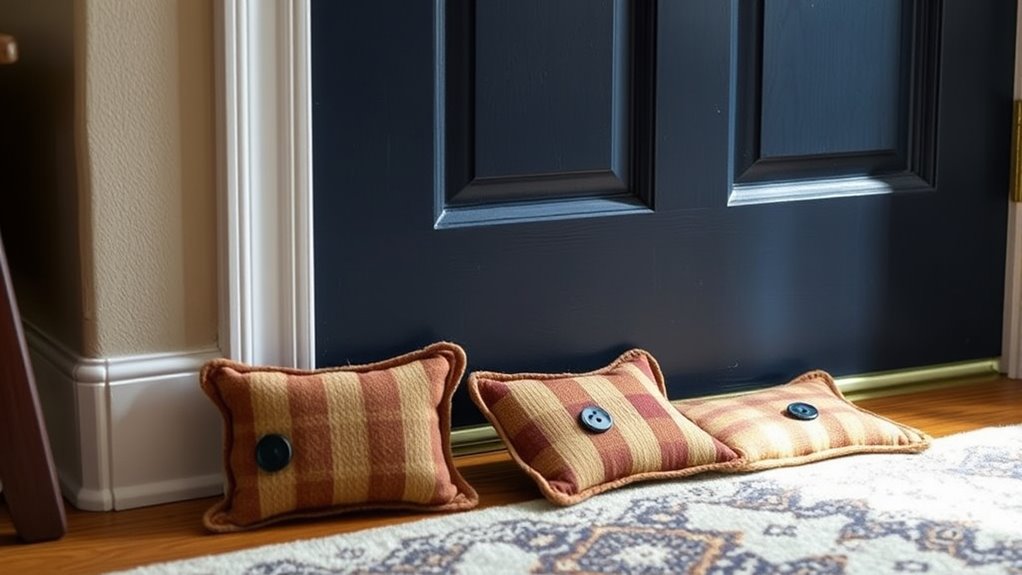To keep your home warmer, you can make your own DIY draft stoppers using simple materials like old fabric, towels, rice, or beans. Measure the gaps around your doors and windows, then craft fabric tubes or wedges to fit snugly. Sew or tie them securely, choosing durable fabrics or cozy ones for extra style. With a few household supplies, you can block cold drafts effectively and save on energy costs. Keep going for more detailed tips and ideas!
Key Takeaways
- Use affordable, readily available materials like old clothing, towels, or rice to craft effective draft stoppers.
- Measure door or window gaps accurately to create custom-sized, snug-fitting draft blockers.
- Sew or tie fabric tubes with durable fabrics and secure openings to prevent insulation materials from spilling.
- Incorporate flexible, wedge-shaped or plush designs for easy placement and removal around gaps.
- Regularly maintain and replace draft stoppers to ensure continued warmth and energy efficiency.

Keeping cold air out and warm air in can be a simple way to cut energy costs, and DIY draft stoppers are an easy solution you can make yourself. These devices block gaps around doors and windows, preventing heat from escaping and cold drafts from sneaking in. The best part is, you don’t need to buy expensive products; you can craft effective draft stoppers with materials you already have at home.
DIY draft stoppers are an affordable way to keep your home warm and energy-efficient.
When considering types of draft stoppers, you have several options. The classic tube-style draft stopper is a long fabric tube filled with insulating material, designed to sit snugly at the base of a door or window. There are also wedge-shaped draft blockers that slip underneath doors or window sashes, providing a tight seal. Some prefer plush fabric drafts or weighted strips that hang along the bottom edge of doors, effectively blocking drafts without taking up much space. You might also opt for custom-shaped draft stoppers tailored to fit specific gaps or irregular spaces. Whatever style you choose, the goal is to create a barrier that’s flexible enough to fit snugly against the surface, yet easy to remove when needed.
Materials for draft stoppers are plentiful and often inexpensive. For the filling, you can use old clothing, towels, rice, beans, or dried beans, which are excellent insulators and readily available. Fabric remnants, old socks, or even pillowcases work well for the outer shell. When selecting fabrics, choose durable, heavy-duty materials like denim, canvas, or upholstery fabric for a long-lasting draft stopper. For a softer, more decorative look, you might opt for fleece or felt. If you want a more eco-friendly option, consider using scrap fabric and natural fillings like dried beans or rice, which are safe and biodegradable.
Making your own draft stopper is straightforward. Measure the length of the gap you want to cover, then cut your fabric to size, leaving extra for seams. Fill the fabric tube with your chosen insulation material, and sew or tie the open end securely. If you’re making a wedge, cut the fabric into a triangular shape, fill it, and sew the edges shut. For hanging strips, simply sew a long piece of fabric, fold it over a rod or attach weights at the bottom, and hang along the door edge. The key is to ensure a tight fit that conforms to the shape of your door or window. Incorporating proper insulation techniques can further enhance the effectiveness of your DIY draft stopper.
In the end, DIY draft stoppers are a practical, cost-effective way to improve your home’s energy efficiency. By choosing the right types of draft stoppers and using materials for draft stoppers you have on hand, you can enjoy a warmer, more comfortable home all winter long while saving on heating bills.
Frequently Asked Questions
How Do I Measure Door Gaps Accurately for Draft Stoppers?
To measure door gaps accurately for draft stoppers, start with measuring tools like a tape measure or a ruler. Do a thorough gap assessment by closing the door and noting the size of the space at the bottom, sides, and top. Use the tape measure to record the widest points. This way, you get precise measurements to create or buy a draft stopper that fits snugly, keeping your home warm and cozy.
Can DIY Draft Stoppers Be Used on Windows?
Absolutely, you can use DIY draft stoppers on windows. Think of them as your modern-day window insulation, preventing drafts just like storm window installation does. To make your own, measure the window gaps carefully, then fill fabric tubes with insulating materials like foam or sand. Place these at the bottom or sides of your windows. They’re a simple, effective way to keep your home cozy without the hassle of professional installations.
What Materials Are Best for Outdoor Draft Stoppers?
For outdoor draft stoppers, you should use weatherproofing fabrics like heavy-duty canvas or nylon that resist moisture and weather. Combine these with insulation materials such as foam, batting, or rubber strips to block cold air effectively. These materials guarantee durability, weather resistance, and good insulation, keeping your outdoor spaces warmer. Choose sturdy, waterproof fabrics and insulating layers to make your draft stoppers last longer and perform well in varying weather conditions.
How Often Should I Replace Homemade Draft Stoppers?
Imagine a chilly morning when your draft stopper suddenly gives way—it’s time to replace it. You should check your homemade draft stoppers during seasonal maintenance; if they show signs of wear or material degradation, replace them. Typically, durable materials last a season or two, but frequent exposure to weather can shorten that. Regular inspection guarantees your homemade draft stoppers continue to keep your home warm and cozy.
Are DIY Draft Stoppers Effective in Extremely Cold Climates?
Yes, DIY draft stoppers can be effective in extremely cold climates if you choose the right materials. Focus on insulation effectiveness and material durability to make certain they block drafts properly and withstand harsh conditions. Use dense fabrics like canvas or heavy felt, and consider adding insulating layers like foam or batting. Regularly check and replace them if they wear out, so your home stays warm and energy-efficient even in the coldest weather.
Conclusion
Now that you’ve crafted your own draft stoppers, you’re ready to embrace the chill without sacrificing comfort. It’s funny how something so simple can make your home feel warmer and more inviting—like wrapping your favorite blanket around your feet. DIY solutions might seem small, but they’re mighty, giving you cozy warmth while saving money. So, embrace the power of your own hands and enjoy a snug, inviting space all winter long.









